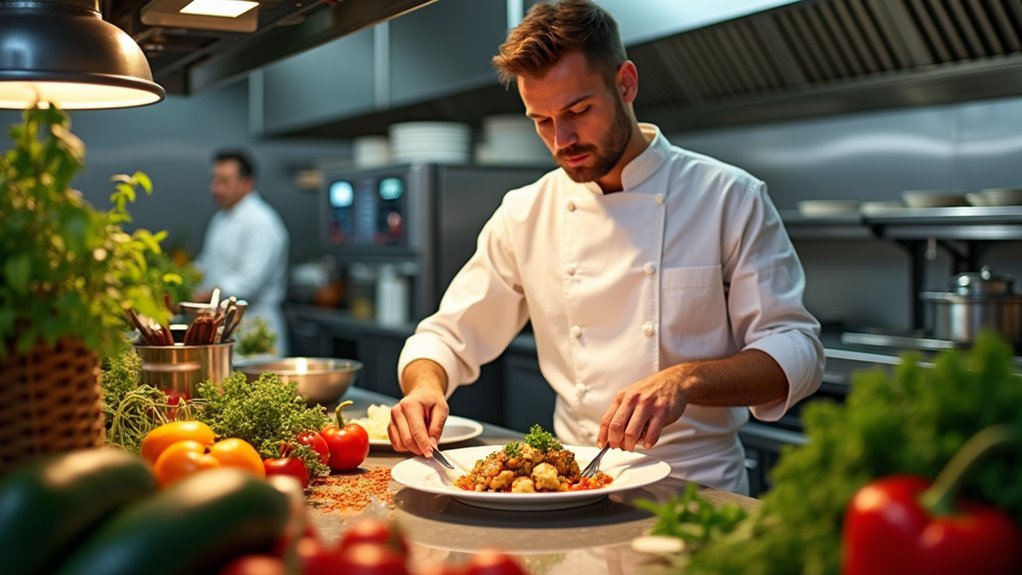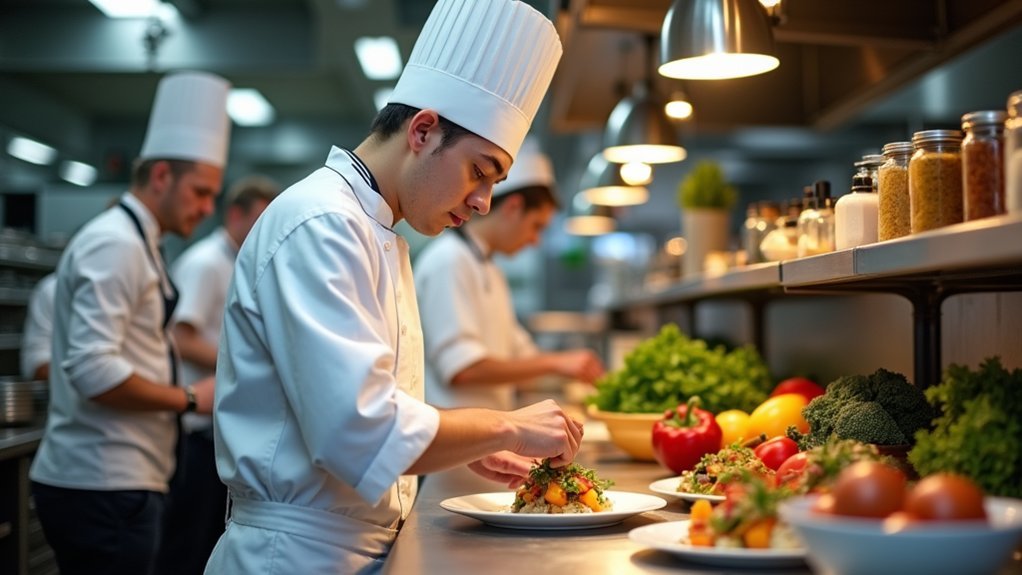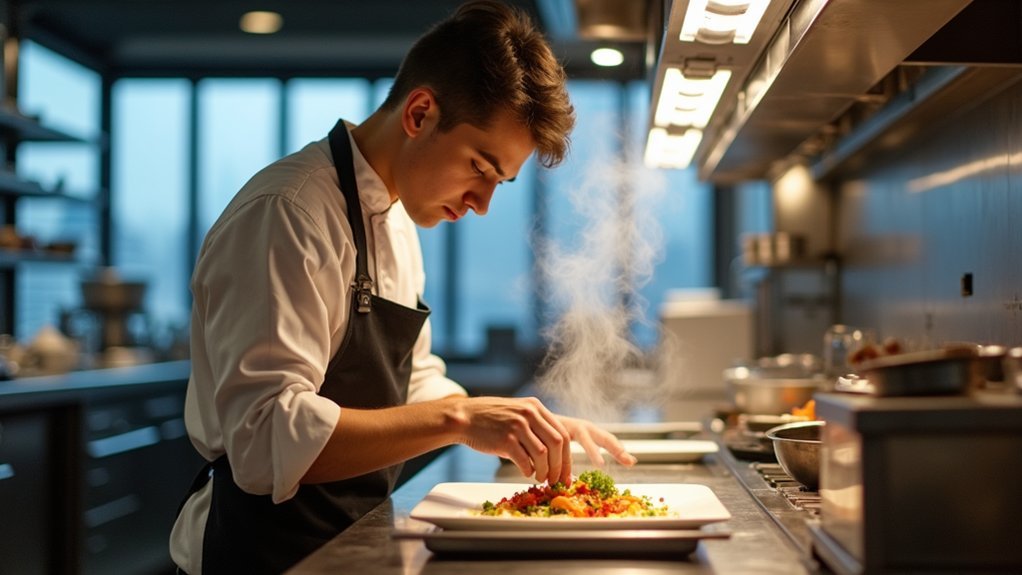Culinary arts is a promising career path for those passionate about food and creativity. It offers diverse opportunities, from cooking to managing and beyond. The industry shows robust job growth, with a 6% increase for cooks expected by 2032. As chef salaries are rising, the field requires dedication because of challenges like long hours and physical demands. Overall, culinary arts offer rewarding prospects for those ready to embrace its dynamic environment. Explore further to understand its full potential.
Key Takeaways
- Culinary arts offer diverse career paths from traditional roles to food media and artisanal manufacturing.
- Job growth is projected with 23,600 new culinary chef positions over the next decade.
- Chef salaries have increased by 24% in the past five years, reflecting industry demand.
- Culinary careers allow for creative expression and rapid advancement despite high-stress environments.
- The industry provides job stability and long-term growth due to consistent consumer demand for food services.
Is Culinary Arts a Good Career Path? Let’s Explore

A career in culinary arts involves a dynamic blend of creativity, technical skill, and hard work, offering a wide range of opportunities from traditional kitchen roles to innovative fields like food media and artisanal manufacturing. Culinary professionals can expect to work in diverse environments, from thriving restaurants and luxury hotels to educational and media settings, with roles such as chefs and food service managers in high demand. The hospitality industry offers potential career benefits that can lead to personal and professional growth. The culinary industry is projected to grow, with the job market for cooks expected to increase by 6% by 2032, adding over 175,000 new jobs. The culinary arts major was the 97th most popular nationwide, with 22,075 degrees awarded in 2021-2022. Despite the industry’s growth, women earn 85¢ for every $1 earned by men, highlighting a persistent gender pay gap that affects job satisfaction and retention. With the expansion of the restaurant industry, culinary graduates can pursue diverse professional options, including executive chef roles and entrepreneurial ventures. While the industry promises growth and numerous advancement opportunities, it likewise requires long hours and physical stamina, making it both a challenging and rewarding path for those passionate about food. The blend of creative and analytical skills is essential, as culinary professionals must balance the artistry of food presentation with precise measurements and safe food preparation.
What does a career in Culinary Arts involve?
A career in culinary arts involves a range of responsibilities, from preparing and presenting dishes to managing kitchen operations. Success in this field requires a blend of skills, including creativity, teamwork, and the ability to perform efficiently in a fast-paced environment. Moreover, culinary professionals must continuously learn and adapt to stay current with industry trends and new cooking techniques. Many chefs and cooks acquire their skills through apprenticeship programs, which offer paid on-the-job training and can last about two years. A career in the culinary arts can also lead to diverse opportunities in areas such as catering, private chef positions, and food writing, allowing professionals to explore their passion in various settings. Despite the unstable job market, dedicated chefs find fulfillment in creating culinary masterpieces and working with talented colleagues. Culinary Arts Degree programs offer comprehensive training that equips aspiring chefs with essential skills like cooking techniques and food safety, which are crucial for thriving in this dynamic industry.
Common responsibilities in Culinary Arts
Starting a career in culinary arts involves a variety of responsibilities that are essential to kitchen operations and food preparation. Key duties include menu planning and ensuring food safety by maintaining sanitized work areas. Chefs prepare and cook dishes while managing inventory and ordering supplies. They additionally coordinate kitchen staff, oversee presentation, and adjust menus based on costs, events, and customer preferences. Culinary arts also emphasize the visual presentation of food, which is a crucial aspect of creating edible works of art. Additionally, chefs must ensure that food is stored and cooked at the correct temperatures, as maintaining food safety is critical in the hospitality industry. Working in the culinary field offers numerous job opportunities beyond traditional restaurant settings, allowing individuals to apply their skills in diverse roles and environments.
Required skills for success
Starting a career in culinary arts requires perfecting a blend of technical, soft, and specialized skills vital for success in the kitchen.
Culinary creativity is key, as chefs must develop unique flavor profiles through adept knife skills and cooking techniques.
Moreover, teamwork, time management, and adaptability are critical in fast-paced environments.
Knowledge of food safety, nutrition, and current culinary trends further improves a chef’s proficiency.
An understanding of nutrition helps chefs create healthier menu options, catering to a wider range of dietary preferences and restrictions.
Is There Demand for Culinary Arts Professionals?
The demand for culinary arts professionals is on the rise, fueled by a broadening industry and consumer interest in diverse dining experiences. With the restaurant industry being the nation’s second largest employer, opportunities for culinary arts graduates are abundant. Culinary arts programs provide foundational knowledge and hands-on training, preparing students for various professional opportunities in the culinary industry. Job growth projections indicate a promising outlook, with chefs and head cooks expected to see an 8.3% increase in employment opportunities through 2033. Economic fluctuations do not diminish the need for food, ensuring job security for culinary professionals. Regional variations in addition highlight significant growth, as seen in areas like the South Central Valley, where culinary arts occupations are projected to grow by 15% over five years.
Industry trends shaping Culinary Arts careers
As the culinary arts environment evolves, various industry trends are shaping career paths for professionals in this field.
Culinary innovations are driving flavor evolution, with complex sauces and globally inspired dishes becoming more prevalent. Chefs are increasingly exploring ethnic cuisines, incorporating traditional ingredients to create unique dining experiences. Interactive dining, such as chef’s tables and live cooking stations, is enhancing customer engagement. The growing demand for skilled chefs across various culinary sectors has led to numerous job opportunities and better salaries. As the popularity of boba tea grows, culinary professionals are also exploring sensory experiences with beverages, adding another dimension to their skill set. Sustainability is another significant trend, influencing how food is sourced and prepared, while AI integration is personalizing dining experiences and improving restaurant efficiency. The increased focus on Italian cuisine, particularly homemade pastas, is capturing the attention of diners and inspiring chefs to refine their techniques in this classic culinary domain.
In addition, the demand for plant-based proteins and zero-proof beverages is rising, reflecting a shift in the direction of healthier choices.
These trends are not merely transforming menus but are inspiring new directions within culinary arts careers.
Job market outlook for Culinary Arts
How does the job market look for culinary arts professionals in the coming years? The culinary field is poised for growth, with a 6% increase in cook positions expected by 2032, creating over 175,000 new jobs. Culinary trends are contributing to this demand, as specialized roles like pastry arts gain traction. In spite of this expansion, 80% of employers struggle to fill vacancies, underscoring the need for skilled professionals. The culinary industry likewise offers high job satisfaction owing to its creative environment and numerous growth opportunities. Financial planning is another career path that involves helping clients manage their finances, showcasing diverse opportunities for those interested in advising roles. Employers are offering better benefits to attract and retain talent in the competitive labor market.
- Culinary Chef Jobs: 23,600 new positions projected over the next decade.
- Post-Pandemic Recovery: Increased demand because of staffing shortages.
- Salary Growth: Chef salaries have risen by 24% in five years.
These factors illustrate a promising career path for aspiring chefs.
Benefits of Working in Culinary Arts

Many individuals are drawn to careers in culinary arts because of the diverse opportunities and creative expression the field offers.
Culinary arts not only provide a platform for crafting innovative dishes but also present a chance for rapid career advancement, especially for those with formal education.
Furthermore, the broadening global food service market guarantees job stability and the potential for financial growth, making it an appealing career choice for many.
Why people choose Culinary Arts as a career
People often choose a career in culinary arts since it offers a unique combination of creativity, job satisfaction, and long-term growth potential. The field allows individuals to express themselves through food during working in a dynamic environment that can lead to diverse career opportunities, such as becoming a chef, food critic, or even a traveling chef. Furthermore, the growing culinary industry guarantees stable job prospects and opportunities for financial advancement, making it an attractive career choice for many. Additionally, strong work ethic and adaptability are soft skills that can significantly enhance success in this field, enabling professionals to thrive in various culinary settings.
Key advantages of working in Culinary Arts
Choosing a career in culinary arts offers numerous advantages that attract individuals to this dynamic field. Engaging with culinary trends and flavor innovation allows chefs to embrace creativity and artistic opportunities.
- Diversity in Cooking Techniques: Explore traditional and modern methods.
- Innovative Dish Creation: Constant creativity in the kitchen.
- Cultural Influences: Incorporate diverse flavors and ingredients.
These elements make culinary arts an enticing career choice.
Long-term growth potential
The allure of long-term growth potential in the culinary arts is a compelling factor for those considering this career path.
With an 8.3% job growth projection through 2033, the field offers diverse roles.
Culinary innovation and food sustainability are key influencers, driving demand in fine dining and globally.
Opportunities in various settings, from restaurants to consultancy, highlight the expansive career possibilities.
Challenges of a Career in Culinary Arts
A career in culinary arts presents several challenges that aspiring chefs need to contemplate. The demanding physical nature of the job requires individuals to spend long hours on their feet, often working during peak times like weekends and holidays, which can complicate personal life management. Furthermore, culinary professionals must navigate high-stress environments, maintain effective teamwork, and continuously update their skills to keep pace with new trends and techniques in the industry. Aspiring chefs should also focus on setting SMART goals to effectively manage their tasks and progress in such a dynamic and challenging field.
Common difficulties in Culinary Arts
Entering the culinary arts can be challenging because of barriers like the high cost of education and the need for specific certifications.
The job market is highly competitive, with many aspiring chefs vying for limited positions, making it vital for individuals to stand out with unique skills and creativity.
Furthermore, continuous innovation and networking are important for career advancement, adding to the pressures faced by those entering the field.
Barriers to entering Culinary Arts
During the pursuit of a career in the culinary arts can be rewarding, several barriers often deter aspiring chefs.
Barrier awareness is essential, as career misconceptions abound. Formal education may lack hands-on experience, and the work environment is demanding.
Moreover, misleading perceptions can affect career decisions.
Barriers include:
- Inadequate practical training
- Long, irregular work hours
- Misunderstandings of the profession’s demands and potential
How competitive is the job market?
As aspiring chefs may face various barriers when entering the culinary arts, the competitiveness of the job market presents further challenges.
Culinary competitions often highlight the demand for specialized skills and experience, emphasizing the importance of job placement strategies.
In spite of a high turnover rate creating constant openings, prestigious roles remain fiercely contested.
Networking and specialized training can provide a significant edge in this dynamic field.
How to Start a Career in Culinary Arts

Pursuing a career in culinary arts begins with selecting the right educational path, which might include formal programs or hands-on training that spans 1-2 years.
Aspiring chefs gain valuable experience through internships and apprenticeships, working in real kitchens to hone their skills and build industry connections.
Entry-level roles provide a solid foundation for learning the ins and outs of the culinary world, setting the stage for future growth and specialization.
Education and training requirements
When starting a career in culinary arts, obtaining recommended certifications can be a valuable step.
Certifications such as the ServSafe Food Handler or Certified Culinarian from the American Culinary Federation provide foundational skills and demonstrate commitment to the profession.
These credentials not just improve a candidate’s resume but likewise increase employability by showing a dedication to maintaining industry standards.
Recommended certifications for Culinary Arts
Certifications play a vital role in the culinary arts, providing aspiring chefs and cooks with credentials that can improve their career prospects.
Certification programs and culinary licenses offer structured pathways for skill validation. They are critical for specialization and advancement in the industry.
- Certified Culinarian (CC): A recognized entry-level certification.
- Certified Executive Chef (CEC): For those with supervisory roles.
- ServSafe Certification: Guarantees food safety expertise.
How to gain experience in Culinary Arts
Initiating an adventure into the culinary arts begins with gaining vital experience, which serves as the foundation for a successful career in this dynamic field.
Aspiring culinary professionals can start by engaging in culinary internships and kitchen volunteering, which provide practical, hands-on experience in a real-world setting. These opportunities allow individuals to develop fundamental skills and understand kitchen dynamics as they work alongside experienced chefs.
Furthermore, internships often open doors to future job placements and valuable industry contacts. Kitchen volunteering offers a chance to learn and grow without the immediate pressure of paid employment, nurturing an environment conducive to learning.
Both avenues are integral for building a strong resume and gaining the experience necessary to thrive in various culinary arts specializations.
Salary & Career Growth in Culinary Arts
The culinary arts field offers diverse salary ranges, with chefs in the U.S. earning an average of about $59,000 annually, whereas those at luxury establishments can earn considerably more.
As the demand for skilled culinary professionals increases, career advancement opportunities are furthermore broadening, with roles emerging in areas like food writing and consulting.
In addition, embracing technology and specializing in areas such as sustainability can improve career growth and lead to higher salaries.
Average salary for Culinary Arts professionals
In the domain of culinary arts, salaries for professionals vary widely based on a range of factors.
Culinary salaries are influenced by work experience, education, and location, causing salary comparisons to show noticeable differences. For instance, the median annual salary for chefs and head cooks stands at $58,920.
Yet, specific roles like sous chefs start at $45,000, whereas executive chefs can earn over $100,000. Furthermore, different sectors such as fine dining and casual restaurants display varied salary ranges.
- Median Salary: Chefs and head cooks earn $58,920 annually.
- Role Variations: Sous chefs start at $45,000, executive chefs earn over $100,000.
- Sector Differences: Fine dining and casual restaurants influence salary disparities.
National averages and regional cost of living similarly play a significant role.
Career advancement opportunities in Culinary Arts
Salaries in the culinary arts provide a snapshot of the profession’s diversity, but comprehension of career advancement offers a broader picture of potential growth.
Culinary leadership roles, such as head or executive chefs, involve managing kitchen operations and innovating menus. Opportunities extend beyond traditional restaurant settings, with entrepreneurial ventures like starting a catering business or leading culinary teams.
The industry likewise offers specialized roles, including artisan producers and R&D chefs. Skills in baking, beverage expertise, and media presentation further enable career growth.
Non-traditional paths, such as food policy advocacy or e-commerce, showcase avenues outside the kitchen. This diverse terrain illustrates that career advancement in culinary arts is multi-faceted, emphasizing both leadership and entrepreneurial spirit.
Moreover, content writing as a professional career can complement culinary arts by enhancing a chef’s ability to articulate recipes, share culinary experiences, and engage a wider audience through blogs or social media.
Is Culinary Arts a Good Career Path? Final Thoughts

Choosing a career in culinary arts can be rewarding, given the projected job growth and diverse opportunities in the industry.
Nevertheless, individuals should consider factors such as the need for formal education, real-world experience, and the varying salary ranges based on roles and locations.
With careful planning and dedication, culinary arts can offer a stable and versatile career path with room for advancement and specialization.
Key takeaways for choosing Culinary Arts as a career
While pursuing a career in culinary arts can be challenging, it offers a wide range of opportunities that extend beyond traditional kitchen roles.
Culinary entrepreneurship and food sustainability are key areas where aspiring chefs can make a significant impact. The industry is not limited to cooking; it includes roles like culinary educators, food writers, and specialty producers, presenting diverse career paths.
Formal culinary training improves job prospects, often leading to entrepreneurial ventures like owning a restaurant. The job market outlook is promising, with significant growth expected for chefs and cooks.
- Culinary entrepreneurship: Opportunities to own or manage food businesses
- Food sustainability: Focus on eco-friendly practices in food production
- Diverse roles: Beyond cooking, options in education, writing, and production
Factors to consider before starting in Culinary Arts
Aspiring chefs considering a career in culinary arts should weigh several important factors before starting on this path.
Culinary career challenges are significant, including long working hours, physical demands, and a high-pressure environment that can lead to stress and burnout. Furthermore, the financial aspects present hurdles, with entry-level positions often offering low starting salaries and job insecurity in an industry sensitive to market conditions.
In spite of these challenges, industry growth factors present opportunities. The culinary industry is growing, driven by labor shortages and a growing demand for skilled professionals. Education can improve career prospects, offering a pathway to stability and potential high earnings with experience.
Prospective chefs should assess their physical and mental endurance, creativity, and stress management skills to thrive in this dynamic field. Cultivating resilience through continuous learning and adaptability can also help chefs overcome challenges and succeed in their culinary careers.
Frequently Asked Questions
What Are the Different Specializations Within Culinary Arts?
Culinary arts encompass specializations such as baking techniques in pastry and bread-making, food presentation in styling, holistic nutrition, hospitality management, beverage curation, and food safety education, each offering diverse career opportunities in various culinary settings.
How Does Technology Impact the Culinary Arts Industry?
As if wielding a magic wand, technology transforms the culinary arts with kitchen automation, streamlining food delivery processes. Innovations like AI-driven menu planning and smart appliances enhance the chef’s role, allowing more focus on creativity and artistry.
What Are the Typical Working Hours for Culinary Professionals?
Culinary professionals navigate varied shift patterns, including early mornings, split shifts, and late nights, impacting work-life balance. They often work 50-70 hours weekly, including weekends and holidays, leading to potential burnout and relationship challenges.
Are There Opportunities for Travel in a Culinary Arts Career?
Culinary careers create countless chances for culinary tourism and travel experiences. Chefs can cook globally, crafting delicious dishes as they discover diverse destinations. Opportunities include working on yachts, guiding food tours, or exploring cuisines through international positions and adventure groups.
What Personality Traits Are Beneficial for Success in Culinary Arts?
Beneficial personality traits in culinary arts include creativity expression, vital for developing unique dishes, and stress management, fundamental for thriving in high-pressure kitchens. Leadership, adaptability, and effective communication further contribute to a successful culinary career.
Conclusion
To sum up, the culinary arts profession is akin to a double-edged knife, offering both the allure of creativity and the challenges of a demanding industry. The field flourishes with opportunities for those passionate about food, yet it requires resilience and dedication. With the right skills and determination, aspiring chefs can carve out a rewarding career. As the culinary world continues to evolve, the path remains inviting for those enthusiastic to embrace its dynamic nature.
